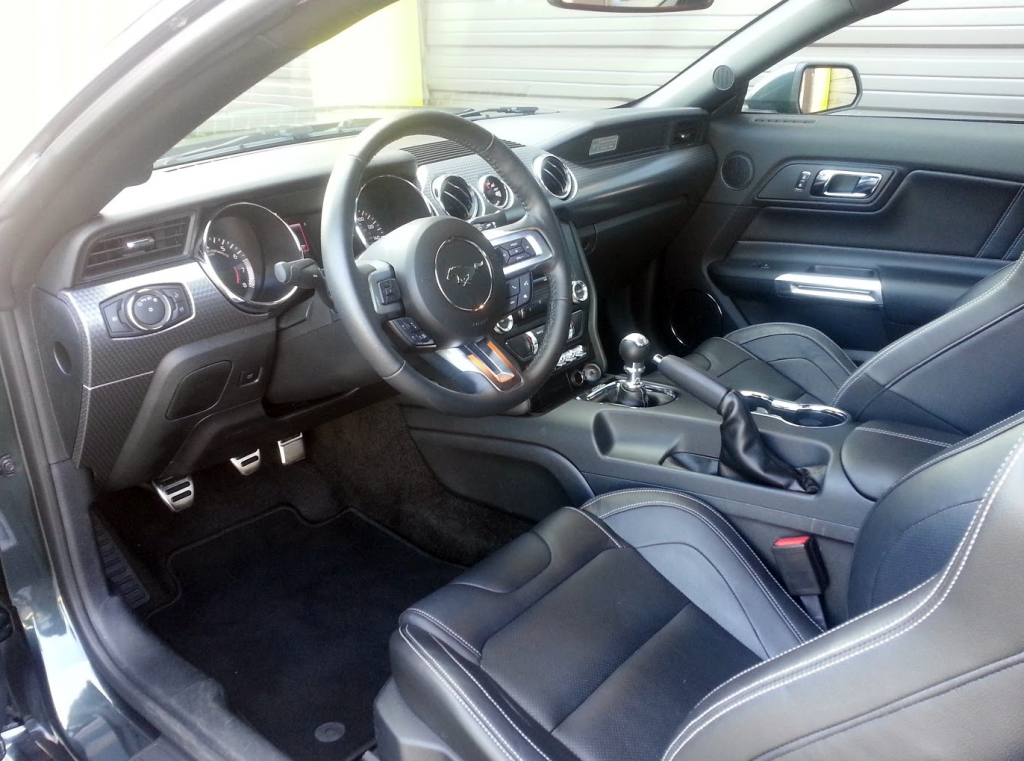
Class: Sporty/Performance Car
Miles Driven: 155
Fuel Used: 11.2 gallons
Driving mix: 60% city, 40% highway
Real-world fuel economy: 13.8
EPA-estimated fuel economy: 15/25/19 (city, highway, combined)
Base price: $36,100 (not including $825 destination charge)
Options on test car: Premium audio system with HD radio ($1795), Enhanced Security Package ($395), adaptive cruise control ($1195), GT Performance Package ($2495), Premier trim package ($395), reverse park assist ($295), Recaro leather seats ($1595), navigation systems ($795)
Price as tested: $45,885
| CG Report Card | |
|---|---|
| Room and Comfort | B+ |
| Power and Performance | A |
| Fit and Finish | B |
| Fuel Economy | D+ |
| Value | B |
| Report-card grades are derived from a consensus of test-driver evaluations. All grades are versus other vehicles in the same class. Value grade is for specific trim level evaluated, and may not reflect Consumer Guide's impressions of the entire model lineup. | |
Quick Hits
The great: Thrilling performance
The Good: Better-than-expected ride quality
The not so good: Uses a lot of gas
More Mustang price and availability Information
John Biel
While the sales of sporty coupes from “popularly priced” brands have for some time been dominated by cars with 4- or 6-cylinder engines, there are still plenty of customers for whom only a V8 will do. The Ford Mustang GT—all new for 2015—continues to cater to their desires.
Consumer Guide® tried out a completely redone 6th-generation GT with Premium trim. In terms of packaging and appointments, it was almost a dead ringer for the 4-cylinder Mustang EcoBoost Premium coupe that CG tested previously. However, in terms of performance and price, the GT clearly was its own car.

The defining feature of the GT is its 5.0-liter V8. For 2015, the aluminum dohc powerplant was improved to make 435 horsepower at 6500 rpm and 400 lb-ft of torque at 4250 rpm, thanks in part to larger valves and freer-breathing ports in the cylinder heads. As such, the GT has the most powerful base V8 on offer in its class, though being king of that hill can sometimes be a short reign. (Chevrolet has announced 455 horsepower for the V8 in its all-new 2016 Camaro SS.)
Test Drive: 2015 Ford Mustang EcoBoost

With 125 more horses on tap than the turbocharged EcoBoost can muster, the GT is certainly stronger. Off-the-line charges are quicker, and getting up to expressway cruising speeds is fluidly rapid. A flick of a toggle switch at the bottom of the instrument panel calls up a choice of drive modes: “Normal,” “Wet/Snow,” “Sport,” or “Track.” The modes mix modified settings for engine response, electronic-stability-control actuation, and, in automatic-equipped cars, transmission calibrations. Selecting Sport or Track modes gets the power to you faster. The GT sounds more like a performance car, too, with a more muscular burble that’s still fairly civilized. You hear it, you enjoy it, but it doesn’t fill up all the space in the cabin—or in your head.
As CG’s test car came with the standard 6-speed manual gearbox, the only transmission-calibration changes were made by the drivers. Ford reports that it redid the shift linkage for ’15 to ease engagement and improve precision. To this tester, who enjoyed the same transmission in the Mustang EcoBoost, the stickshift GT seemed a little more difficult to drive well from a start or at lower speeds. The clutch pedal in the GT felt a little stiffer, which made it trickier to modulate while easing into the gas during normal “good-citizen” street driving, inducing moments of bogging hesitation.
The Mustang GT is not a car for folks with a fear of gas stations. Its EPA ratings are 15 mpg in the city, 25 on the highway, and 19 combined. This driver saw just 13.83 mpg after a trip of 155 miles that was made up of 61 percent city-type driving.
Shelby GT350 Mustang: Relaunching a Legend

Base price for the GT Premium in this test was $36,100, which is $6800 more than the starting tab for an EcoBoost Premium coupe. In addition to the meatier engine, the GT provides larger-diameter brake rotors with 4-piston calipers in front, electronic line-lock, an engine oil cooler, and air-extracting hood vents. Manual-transmission cars also get launch control. Like the EcoBoost, the GT comes with dual bright exhaust tips and a decklid spoiler, though their designs are different.
CG’s test car came to $45,885 delivered, thanks to a complement of options like a Shaker 12-speaker audio system, adaptive cruise control, very grippy Recaro front seats, and the Performance Package. This last item is different—and costlier—than the Performance Package that was on our EcoBoost test car. Both have things like heavier-duty front springs and rear sway bar, a larger radiator, enhanced brakes, and a spoiler delete. The GT adds an underhood brace running between the shock towers, a “K” brace in the chassis, 6-piston front brake calipers, staggered-width front and rear tires on 19-inch black aluminum wheels with a GT-specific design, and a 3.73:1 Torsen limited-slip rear axle.

You won’t find the ride in the GT—now featuring Mustang’s across-the-board adoption of independent rear suspension—especially punishing. Cornering is fairly flat, at least in the “normal” driving through which this driver put the car. Another dash switch permits adjusting the electrically assisted power steering to “Normal,” “Sport,” or “Comfort” settings. Normal and Comfort are just degrees apart in feel, but Sport does offer slightly more resistance. The summer tires did raise some noise at expressway speeds.
Notable standard comforts and conveniences include leather upholstery, heated power mirrors, dual-zone climate control, ambient lighting, a tilt-telescoping steering column, SYNC and MyFord Touch infotainment-system management, Track Apps for timing and other performance functions, and a rearview camera. One word of warning from personal experience: Don’t grab the hood prop rod with a bare hand immediately after running the car for a while. Underhood heat makes it too hot to handle right away. As for the rest of the GT, performance-car customers ought to find it just about right.
Remember when the Mustang had T-Tops?





